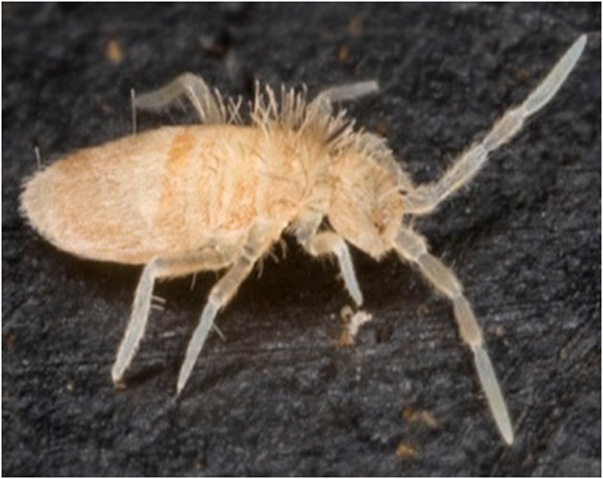Pesticides are more toxic for soil organisms in dry soil and at enhanced temperatures

The experiment, also conducted using the species Sinella curviseta showed a significant influence of extreme cli-matic conditions on the toxicity of the fungicide pyrimethanil. © C. Bandow
The study by scientists from the LOEWE Biodiversity and Climate Research Centre (BiK-F), the Goethe University and the ECT Oekotoxikologie GmbH was published in the September issue of the journal “Applied Soil Ecology”.
Springtails are tiny, about 10 mm large creatures, which participate in essential soil functions. Its numerous species, include Folsomia candida and Sinella curviseta, and are widely distributed. They form part of a huge crowd of soil organisms, which decompose organic material and build up humus. If springtails are affected, therefore soil fertility will be affected too.
As the new study shows, low soil moisture (i.e. 30 % of the water holding capacity) leads to significant reduction of springtail juveniles. “We experimented with two different species of springtails. Both of them – but especially Folsomia candida – might have difficulties to produce enough offspring to keep a population stable in dry soil,” says Cornelia Bandow, an ecologist at ECT Ecotoxicology GmbH, who conducts research for the German Biodiversity and Climate Research Centre (BiK-F).
Extreme climate conditions may also alter the effect of pesticides on soil organisms. “Low soil moisture and enhanced temperatures significantly lower the threshold upon which the fungicide pyrimethanil may be toxic.” explains Cornelia Bandow. In the framework of this study the toxic threshold refers to the concentration of the fungicide at which the population is 50 % less than in an uncontaminated soil. Thus at 26 degrees and a soil moisture of 30 % the threshold was up to half of the threshold that was measured at 20 degrees and 50 % soil moisture.
The experiment was conducted using 66 test vessels filled with a standard soil which was treated with different concentrations of pyrimethanil. Pyrimethanil is a broad spectrum fungicide, which is used on strawberries, pome fruit and vine to protect against and treat fungal infestation. To test for future climate conditions, the experiments were performed independently at two different temperatures of 20 degrees and 26 degrees. The soil was furthermore moistened to different moisture levels. After 28 days researchers counted the individuals to determine the reproductive success of the model organisms under the different climatic conditions.
Should fungicides thus be avoided at all so as not to harm soil organisms? Not necessarily. “A risk for springtails under field conditions may not be expected as the toxic threshold of pyrimethanil is far above the maximum concentrations that may occur in soil if the fungicide is used according to existing regulations,” says Bandow and adds “It depends on the species and the substance whether the sensitivity alters under extreme climate conditions or not.” Therefore, the researchers also plan to test several other pesticides using a variety of soil organisms.
Paper:
Bandow, Cornelia, Karau, Nora, Römbke, Jörg. Interactive effects of pyrimethanil, soil moisture and temperature on Folsomia candida and Sinella curviseta (Collembola).
– Applied Soil Ecology, DOI: 10.1016/j.apsoil.2014.04.010
For more information please contact:
Cornelia Bandow
LOEWE Biodiversität und Klima Forschungszentrum (BiK-F) &
ECT Oekotoxikologie GmbH
Tel. +49 (0) 6145 9564 11
c.bandow@ect.de
or
Sabine Wendler
LOEWE Biodiversität und Klima Forschungszentrum (BiK-F),
Press officer
Tel. +49 (0)69 7542 1838
Sabine.wendler@senckenberg.de
LOEWE Biodiversity and Climate Research Centre, Frankfurt am Main, Germany
With the objective of analysis the complex interactions between biodiversity and climate through a wide range of methods, the Biodiversität und Klima Forschungszentrum [Biodiversity and Climate Research Centre] (BiK‐F) has been funded since 2008 within the context of the Landes‐ Offensive zur Entwicklung Wissenschaftlichökonomischer Exzellenz (LOEWE) of the Land of Hessen. The Senckenberg Gesellschaft für Naturforschung and Goethe University in Frankfurt as well as other, directly involved partners, co‐operate closely with regional, national and international institutions in the fields of science, resource and environmental management, in order to develop projections for the future and scientific recommendations for sustainable action. For further details, please visit www.bik‐f.de
Media Contact
All latest news from the category: Ecology, The Environment and Conservation
This complex theme deals primarily with interactions between organisms and the environmental factors that impact them, but to a greater extent between individual inanimate environmental factors.
innovations-report offers informative reports and articles on topics such as climate protection, landscape conservation, ecological systems, wildlife and nature parks and ecosystem efficiency and balance.
Newest articles

Nerve cells of blind mice retain their visual function
Nerve cells in the retina were analysed at TU Wien (Vienna) using microelectrodes. They show astonishingly stable behavior – good news for retina implants. The retina is often referred to…

State-wide center for quantum science
Karlsruhe Institute of Technology joins IQST as a new partner. The mission of IQST is to further our understanding of nature and develop innovative technologies based on quantum science by…

Newly designed nanomaterial
…shows promise as antimicrobial agent. Rice scientists develop nanocrystals that kill bacteria under visible light. Newly developed halide perovskite nanocrystals (HPNCs) show potential as antimicrobial agents that are stable, effective…



